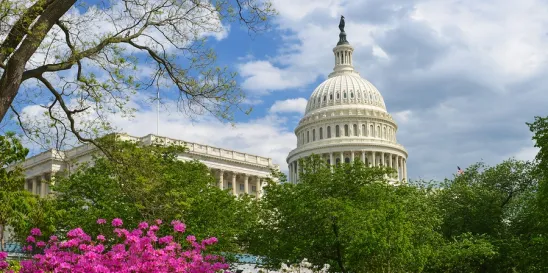The U.S. Department of Energy (DOE) announced in mid-January that it is investing more than $104 million for energy conservation and clean energy projects at clean energy facilities. This is the first of three disbursements from a total of $250 million funded by the Bipartisan Infrastructure Law to achieve President Joe Biden’s goals of a 65 percent reduction in greenhouse-gas emissions from federal operations by 2030, along with 100 percent zero-emission vehicle acquisitions by 2035 and a net-zero building portfolio by 2045.
This investment also aligns with the Biden administration’s December 2022 Federal Building Performance Standard (FBPS), which calls for federal agencies to achieve zero direct greenhouse gas emissions in 30 percent of government-owned buildings by 2030.
The funding will come via the DOE’s Assisting Federal Facilities with Energy Conservation Technologies (AFFECT) program that was established in 1992: The AFFECT program is managed by the Federal Energy Management Program (FEMP) and provides funding to federal agencies to help meet energy and water-related goals by identifying affordable solutions, facilitating public-private partnerships, and leveraging best practices to promote energy leadership.
Potential Opportunities for Private Government Contractors, Consultants
While the DOE is funding the clean energy improvements, most of the work is going to be bid out to private government contractors and consultants. This is just the first $104 million: there will be almost $150 million more doled out for additional federal agency clean energy and energy conservation projects over the next two years, much of which will be contracted to the private sector. These projects are being done all around the country, are multifaceted and will require a broad range of contractor and consultant support.
Sixteen different agencies applied for this round of AFFECT funding, which was divided into three areas: Assistance with Net-Zero Buildings Opportunity Development; Modification of Existing Projects for Net-Zero Buildings, and New/In Development Net-Zero Buildings Projects.
Projects were selected for 31 facilities in 18 states, the District of Columbia, and Germany that were proposed by the following nine agencies: the Social Security Administration; the U.S. Departments of Commerce, Defense, Energy, the Interior, Transportation, and Veterans Affairs; the U.S. General Services Administration; and the U.S. Office of Personnel Management. These projects include:
- The U.S. Department of Defense (DOD) was awarded more than $55 million for base energy efficiency projects, including $10 million for installation of rooftop solar panels, a heat-recovery heat pump system, and solar thermal panels to reduce reliance on natural gas and fuel oil combustion systems at the Pentagon. HVAC recommissioning, solar photovoltaic (PV), and heat pump installations are planned to enhance energy efficiency. The DOD received $45 million more to support seven other projects at Army, Navy, Air Force, and Marine Corps services bases throughout the U.S. and at the U.S. Army Garrison in Wiesbaden, Germany.
- The U.S. Department of Transportation will implement three energy conservation measures to assist in achieving LEED platinum status at its headquarters in Washington, D.C., including the installation of LED lights and occupancy sensors in low-occupancy areas and application of PV film on south-facing windows to conserve and generate energy. It is estimated that these measures will reduce energy consumption by 2.8 GWh/year and achieve total savings of 8,679 MMBtu/year.
- The Social Security Administration (SSA) plans a feasibility study to retrofit its supply building's HVAC system, transitioning from a conventional variable air volume hydronic system to a more efficient model. Anticipated outcomes include an energy-efficient HVAC system aligning with federal standards and the potential elimination of scope 1 emissions. Additionally, the study will explore integrating a 300-kW PV system to move the SSA campus closer to near net-zero or net-zero emissions.
- One of DOE’s projects will focus on replacing the aging chilled water system at its Savannah River Site in Aiken, South Carolina, with modern, water-cooled, variable flow magnetic bearing chillers. Funding for this project will also help the DOE implement a critical project planned since 2019, but stalled due to a shortage of funds: installing a 10-MW PV solar array and battery energy storage system on about 70 acres.
- A second DOE project at the James V. Forrestal Federal Building in Washington, D.C., will upgrade more than 86,000 square feet of windows as an innovative response to obtaining affordable thermally efficient windows with limited impact to building occupants and operations. This project will transform the windows from original 1960's single‐pane to add double‐pane, low‐e secondary windows on the interior of the building. The thermal performance of the windows will be quadrupled by the project.
- The National Oceanic and Atmospheric Administration was awarded $5 million to purchase solar panels and battery storage systems that will enable the Mauna Loa atmospheric baseline observatory in Hawaii to operate on renewable energy and support the conversion of that observatory in Hawaii to a net-zero carbon facility.
Public, Private Economic and Energy Efficiency Benefits
The selected projects are expected to:
- Double the amount of current onsite carbon-free electricity at federal facilities over the amount brought online in 2022, resulting in 27 MWs of additional capacity
- Leverage more than $361 million in private investment
- Demonstrate replicable and scalable projects for the entirety of the federal government
The DOE estimates that in the first year of operation, the projects will drastically reduce the federal carbon footprint by:
- Removing the same amount of greenhouse gas emissions from the air as taking 23,042 gasoline-powered vehicles off the roads
- Reducing energy usage by the equivalent of 29,662 homes’ annual electricity use
- Saving more than $29 million in energy and water costs
The submission deadline for the second round of AFFECT funding is April 19, 2024. Phase 2 selection notifications are expected in fall 2024. The Phase 3 application process will take place in spring 2025.
Takeaways
While applicants are limited to federal government agencies, they may opt to be supported by private sector partners when developing applications for potential projects. FEMP encourages all energy and sustainability stakeholders across federal agencies, as well as private sector organizations and utilities, to engage in the program to drive clean, healthy, and resilient federal operations.
These timely concrete steps by major government agencies to meet the administration’s ambitious climate objectives for federal facilities in traditional and innovative ways is a strong signal of unified governmental support for and progress toward the administration’s overall climate policy goals. As Albert Schweitzer famously observed: “Example is not the main thing in influencing others. It is the only thing.”




 />i
/>i

